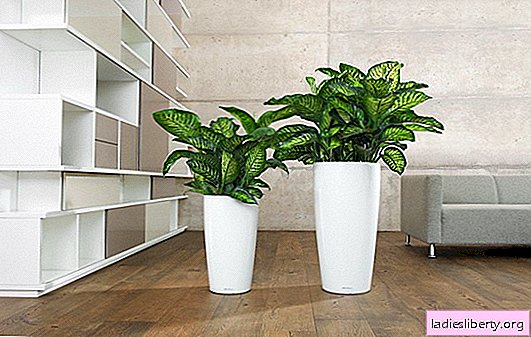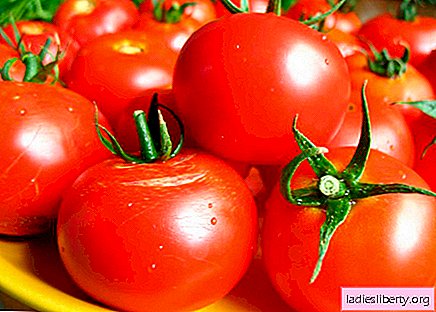
A chic green beauty with large leaves, Dieffenbachia, is actually not such an unpretentious plant.
Like any perennial, it requires a certain attention to its health.
The decorative qualities of Dieffenbachia directly depend on the degree of care.
What you need to know about caring for dieffenbachia at home?

The plant's favorite place is partial shade in summer and a well-lit area in the autumn-winter period. It is very important to maintain a balance of light, since an excess of ultraviolet rays will burn delicate greens, the leaves will quickly turn yellow and fall off; a flaw will destroy their decorative qualities: the variegation will disappear, and the plant will become a faded reproach to the negligent owners. About the same reaction (in particular, yellowing of the leaves) will be observed during overheating or overcooling of Dieffenbachia, therefore flower growers do not recommend ignoring the temperature regime that the flower prefers.
For example, one of several dozen varieties, Dieffenbachia Camille, loves 22 ° C in summer and 18 ° C in winter. Moreover, in the hot period, she calmly tolerates 30 ° C, subject to regular spraying and bathing. The flower reacts to any draft, including normal ventilation, by drying the tips of the leaves and forming brown or pale yellow spots, so it is best to move the tub with dieffenbachia to the next room each time the window is opened.

How to water Dieffenbachia, caring for it at home
Bathing is a separate chapter in the history of this amazing plant. Long-standing experience of gardeners says that a 15-minute immersion of an earthen coma in room temperature water is only good for Dieffenbachia. During intensive growth, such a procedure is arranged monthly, be sure to let the water drain well. And in the winter, "sleepy" period, when most houseplants prefer moderate and infrequent watering, this beauty requires an abundance of water. However, here you also need to know the measure: overmoistening can ruin the green beauty. The first sign of excess fluid is browning and leaf dying.

It is necessary to develop a unique irrigation scheme for each plant in order to prevent either drying out of the soil substrate or stagnation of water at the roots: about once every 3 days in the summer, and once every 5-6 days in the winter. Dieffenbachia favorably reacts to regular spraying of leaves, and if in a heat to put a container with a plant on plentifully moistened peat, then it is possible to 100% to keep the darling in a state of "golden mean". A wonderful effect is exerted on the general condition of the plants by melt, rain, or simply water, which they have stood for several days - the liquid becomes softer, which has a beneficial effect on the health of the flower.
According to the demanding attitude of the plant to watering and air temperature, we can conclude that Dieffenbachia is incredibly picky in terms of fertilizers. I hasten to dispel all doubts: any universal mineral-based fertilizer is suitable. But you will have to feed often, at least once every 10 days, since the flower develops quickly enough and consumes a huge amount of nutrients.
Independent transplantation and reproduction of Dieffenbachia when leaving at home
It is advisable to plant and transplant the plant either in a ready-made substrate intended specifically for the Aronium family, or independently make a collection of turf and leafy soil, sand and peat in a ratio of 4: 1: 1: 1. The resulting soil will have the neutral acidity that Dieffenbachia loves so much. Mandatory drainage. When replanting in February-May, it is replaced with a new one, and the plant, along with a lump of land, is transshipped into a container whose diameter is a couple of centimeters larger than the previous pot.
But what about an adult plant, the lower leaves of which gradually fall and reduce the attractiveness of Dieffenbachia? You just need to “rejuvenate” the flower by cutting off the top and rooting it in a mixture of peat and sand (1: 1) or water. In the process of rooting, it is better to create a mini-greenhouse made of polyethylene, or simply cover the stalk with a glass jar. The pot is placed in a well-lit place, which does not fall in direct sunlight, and patiently wait for germination. With water rooting, the top with roots of 3-4 cm is transplanted into the prepared soil, and in the second case, a drug is added weekly to stimulate root growth. When the time comes to transplant the plant to a permanent place, they monitor the integrity of the earthen coma: fragile young roots are easy to damage.

Another slow but effective way of rooting will require a considerable amount of patience from the grower, as dieffenbachia from the cuttings can grow up to 12 months. Pieces of the stem 10-15 cm in size, powdered with charcoal and dried for 15-20 hours, are horizontally laid in the prepared substrate so that half is in the ground. They monitor the condition of the handle: if there is no visible damage, then continue to water and feed. After the first leaf appears, soil is added, and then you can start transplanting. The mother piece is left, as new shoots may form from it. Old plants with a bare stem are cut so that a stalk about 15 cm high remains above the ground.

What can harm dieffenbachia when caring for her at home
Dieffenbachia has two main adversaries: improper care and pests. The first includes irregular watering and lack of top dressing, the device of the place of residence of the plant in the wrong place. Of the pests, the most common are spider mites, aphids and scale insects.

The first sign of illiterate flower maintenance is the loss of its decorative appearance. Yellowed or even falling leaves, the appearance of ugly brown or scorched spots on their plates indicate that the plant was positioned incorrectly. In order to avoid the death of Dieffenbachia, it is urgently necessary to reconsider the conditions of its maintenance: whether the necessary temperature conditions are observed, whether there are drafts to which the flower is very sensitive and almost instantly reacts to their appearance by giving the leaves a yellow pigment. Or maybe you just need to water: in each case there are reasons for the deterioration of the appearance of the plant, and to be safe you need to double-check all of them. When transplanting, it is mandatory to check the state of the root system: if there are rotten roots, then they must be removed and sprinkled with slices of potassium permanganate or charcoal.
If the inspection of the plant showed that all damage to Dieffenbachia comes from outside, then the leaves and stem are treated with an ordinary cotton swab, after moistening it with simple but effective means: strong soapy solution, beer, garlic infusion. Especially damaged areas are additionally treated with malathion.
With proper supervision, the plant can please the owners with good growth and high decorativeness: growing to 1.5-2 m, Dieffenbachia will become a real decoration that can bring the atmosphere of the tropics to any room.











